
Chess is a recreational and competitive board game played between two players. It is sometimes called Western or international chess to distinguish it from related games such as xiangqi. The current form of the game emerged in Southern Europe during the second half of the 15th century after evolving from similar, much older games of Indian and Persian origin. Today, chess is one of the world's most popular games, played by millions of people worldwide at home, in clubs, online, by correspondence, and in tournaments.

A chessboard is the type of gameboard used for the game of chess, on which the chess pawns and pieces are placed. A chessboard is usually square in shape, with an alternating pattern of squares in two colours. Though usually played on a surface, a tangible board is not a requirement to play the game. Traditionally wooden boards are made of unstained light and dark brown woods. To reduce cost, many boards are made with veneers of more expensive woods glued to an inner piece of plywood or chipboard. A variety of colours combinations are used for plastic, vinyl, and silicone boards. Common dark-light combinations are black and white, as well as brown, green or blue with buff or cream. Materials vary widely; while wooden boards are generally used in high-level games; vinyl, plastic, and cardboard are common for less important tournaments and matches and for home use. Decorative glass and marble boards are rarely permitted for games conducted by national or international chess federations. When they are permitted, they must meet various criteria
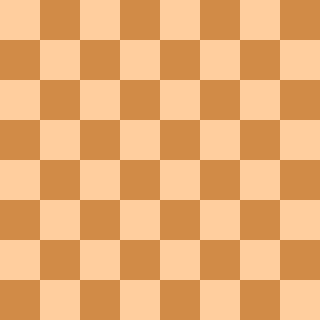
Castling is a move in the game of chess involving a player's king and either of the player's original rooks. It is the only move in chess in which a player moves two pieces in the same move, and it is the only move aside from the knight's move where a piece can be said to "jump over" another.
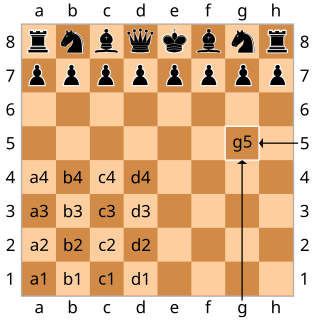
Algebraic notation is the standard method for recording and describing the moves in a game of chess. It is based on a system of coordinates to uniquely identify each square on the chessboard. It is used by most books, magazines, and newspapers. In English-speaking countries, the parallel method of descriptive notation was generally used in chess publications until about 1980. A few players still use descriptive notation, but it is no longer recognized by FIDE, the international chess governing body.
Descriptive notation is a notation system for recording chess games which was used in English, Spanish and French chess literature until about 1980. It has been superseded by algebraic notation, which is more concise and requires less effort to avoid ambiguity. The international chess governing body FIDE stopped recognizing descriptive notation in 1981.
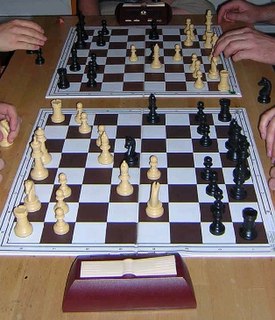
Bughouse chess is a popular chess variant played on two chessboards by four players in teams of two. Normal chess rules apply, except that captured pieces on one board are passed on to the teammate on the other board, who then has the option of putting these pieces on their board.
This glossary of chess explains commonly used terms in chess, in alphabetical order. Some of these terms have their own pages, like fork and pin. For a list of unorthodox chess pieces, see Fairy chess piece; for a list of terms specific to chess problems, see Glossary of chess problems; for a list of named opening lines, see List of chess openings; for a list of chess-related games, see List of chess variants.
A fairy chess piece, variant chess piece, unorthodox chess piece, or heterodox chess piece is a chess piece not used in conventional chess but incorporated into certain chess variants and some chess problems. Compared to conventional pieces, fairy pieces vary mostly in the way they move, but they may also follow special rules for capturing, promotions, etc. Because of the distributed and uncoordinated nature of unorthodox chess development, the same piece can have different names, and different pieces the same name in various contexts. Almost all are usually symbolised as inverted or rotated icons of the standard pieces in diagrams, and the meanings of these "wildcards" must be defined in each context separately. Pieces invented for use in chess variants rather than problems sometimes instead have special icons designed for them, but with some exceptions, many of these are not used beyond the individual games for which they were invented.
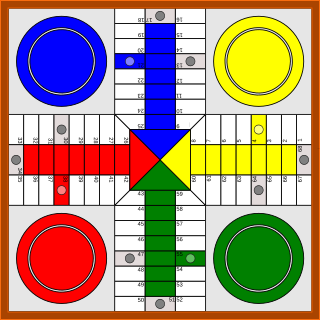
Parchís is a Spanish board game of the Cross and Circle family. It is an adaptation of the Indian game Pachisi. Parchís was a very popular game in Spain at one point as well as in Europe and Morocco, and it is still popular specially among adults and seniors. Since it uses dice, Parchís is not usually regarded as an abstract strategy game like checkers or chess. It does not depend entirely on luck either, since the four pawns under a player's command demand some sort of strategy.
![Quoridor Quoridor is a 2 or 4-player board game designed by Mirko Marchesi and published by [[Gigamic]]. The game has received great numbers of awards](https://upload.wikimedia.org/wikipedia/commons/thumb/8/84/Quoridor_1.jpg/320px-Quoridor_1.jpg)
Quoridor is a 2 to 4-player intuitive strategy game designed by Mirko Marchesi and published by Gigamic Games. Quoridor received the Mensa Mind Game award in 1997 and the Game Of The Year in the USA, France, Canada and Belgium.

Crazyhouse is a chess variant similar to bughouse chess, but with only two players. It effectively incorporates a rule from the game shogi, in which a player can introduce a captured piece back to the chessboard as their own.
Yari shogi is a modern variant of shogi ; however, it is not Japanese. It was invented in 1981 by Christian Freeling of the Netherlands. This game accentuates shogi’s intrinsically forward range of direction by giving most of the pieces the ability to move any number of free squares orthogonally forward like a shogi lance. The opposite is true of promoted pieces which can move backward with the same power.
Heian shōgi is a predecessor of modern shogi. Some form of chess almost certainly reached Japan by the 9th century, if not earlier, but the earliest surviving Japanese description of the rules dates from the early 12th century. Unfortunately, this description does not give enough information to actually play the game, but this has not stopped people from attempting to reconstruct this early form of shogi.
Shō shōgi is a 16th-century form of shogi, and the immediate predecessor of the modern game. It was played on a 9×9 board with the same setup as in modern shogi, except that an extra piece stood in front of the king: a 'drunk elephant' that promoted into a prince, which is effectively a second king. While 9×9 may not seem 'small', it was smaller than the other shogi variants prevalent at the time, which were the 12×12 chu shogi and 15×15 dai shogi. According to the Sho Shōgi Zushiki, the drunk elephant was eliminated by the Emperor Go-Nara, and it is assumed that the drop rule was introduced at about the same time, giving rise to shogi as we know it today.
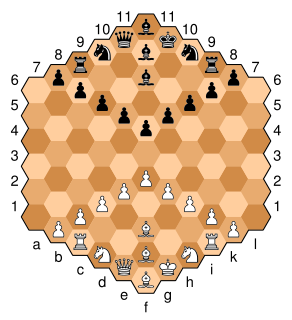
Hexagonal chess refers to a group of chess variants played on boards composed of hexagon cells. The best known is Gliński's variant, played on a symmetric 91-cell hexagonal board.
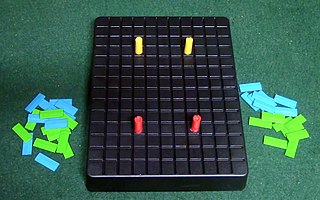
Blockade is a strategy board game for two players with the motto "beat the barrier". It's played on a board with an 11x14 grid of spaces, barriers and 2 mobile playing pieces per player. The object of the game is to maneuver ones pieces around barriers and into the opponents starting spaces. The game is long out of production.
Omega Chess is a commercial chess variant designed by Daniel MacDonald. The game is played on a 10×10 board with four extra squares, each added diagonally adjacent to the corner squares. The game is laid out like standard chess with the addition of a champion in each corner of the 10×10 board and a wizard in each new added corner square.
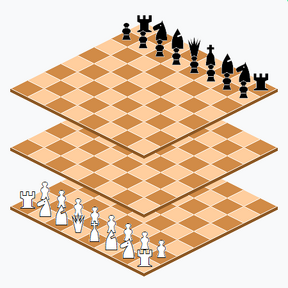
Millennium 3D chess is a three-dimensional chess variant created by William L. d'Agostino in 2001 which employs three vertically stacked 8×8 boards, with each player controlling a standard set of chess pieces. The inventor describes his objective as "extending the traditional chess game into a multilevel environment without distorting the basic game."

The following outline is provided as an overview of and topical guide to chess:
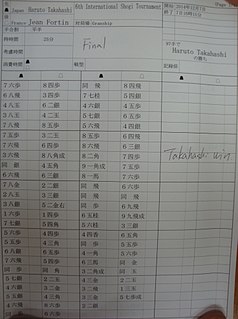
Shogi notation is the set of various abbreviatory notational systems used to describe the piece movements of a shogi game record or the positions of pieces on a shogi board.






![Quoridor Quoridor is a 2 or 4-player board game designed by Mirko Marchesi and published by [[Gigamic]]. The game has received great numbers of awards](https://upload.wikimedia.org/wikipedia/commons/thumb/8/84/Quoridor_1.jpg/320px-Quoridor_1.jpg)




